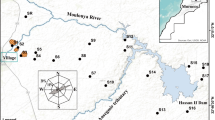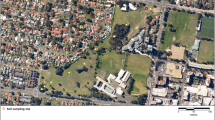Abstract
The leaching tests, including the Toxicity Characteristic Leaching Procedure (TCLP), EDTA extraction and BCR sequential extractions before and after EDTA treatments, were performed on two specific soils to elucidate heavy metal-associated mineral fractions and general leachability. The TCLP illustrated the low leachability of heavy metals in soils from two sites. EDTA is a strong chelator and therefore had higher extraction efficiency compared to that of TCLP. The lower extraction percentages by EDTA for As and Sb were found compared to the other heavy metals derived from anthropogenic sources. Sequential extractions showed that the importance of acid-extractable, organically-bound and Fe–Mn oxide fractions was identified for anthropogenic heavy metals with the exception of As and Ni while the importance of residual fraction was identified for endogenous metals. Changes in sequential fractions of heavy metals after leaching with EDTA are very complex and it is difficult to generalize on which fraction was more mobile than the others. These combined results are helpful in elucidating the association of heavy metals to soil fractions and the mobility characteristics of heavy metals under certain environmental conditions.
Similar content being viewed by others
References
Abollino, O., Aceto, M., Malandrino, M., Mentasti, E., Sarzanini, C., & Barberis, R. (2002). Distribution and mobility of metals in contaminated sites: Chemometric investigation of pollutant profiles. Environmental Pollution, 119, 177–193.
Barona, A., Aranguiz, I., & Elias, A. (2001). Metal associations in soils before and after EDTA extractive decontamination: Implications for the effectiveness of further clean-up procedures. Environmental Pollution, 113, 79–85.
Bretzel, F., & Calderisi, M. (2006). Metal contamination in urban soils of coastal Tuscany (Italy). Environmental Monitoring and Assessment, 118(1–3), 319–335.
Herreweghe, S. V., Swennen, R., Vandecasteele, C., & Cappuyns, V. (2003). Solid phase speciation of arsenic by sequential extraction in standard reference materials and industrially contaminated soil samples. Environmental Pollution, 122, 323–342.
Hjortenkrans, D., Bergback, B., & Haggerud, A. (2006). New metal emission patterns in road traffic environments. Environmental Monitoring and Assessment, 117(1–3), 85–98.
Kaminski, M. D., & Landsberger, S. (2000). Heavy metals in urban soils of East St. Louis, IL Part 2: Leaching characteristics and modeling. Journal of Air & Waste Management Association, 50, 1680–1687.
Kirby, C. S., & Rimstidt, J. D. (1993). Mineralogy and surface properties of municipal solid waste ash. Environmental Science & Technology, 27, 652–660.
Li, X., Coles, B. J., Ramsey, M. H., & Thornton, I. (1995). Chemical partitioning of the new national institute of standards and technology standard reference materials by sequential extraction using inductively coupled plasma atomic emission spectrometry. Analyst, 120, 1415–1419.
Lund, W. (1990). Speciation analysis—Why and how? Fresenius’ Journal of Analytic Chemistry, 337, 557–564.
McGrath, S. P. (1987). Long-term studies of metal transfers following applications of sewage sludge. In P. J. Coughtrey, M. H. Martin, & M. H. Unsworth (Eds.), Pollutant transport and fate in ecosystems. Special Publication No.6 of the British Ecological Society (pp. 301–317). Oxford: Blackwell.
Rauret, G. (1998). Extraction procedure for the determination of heavy metals in contaminated soil and sediment. Talanta, 46, 449–455.
Singh, S., & Kumar, M. (2006). Water and vegetables in peri-urban Delhi. Environmental Monitoring and Assessment, 120(1–3), 79–91.
Sun, B., Zhao, F. J., Lombi, E., & McGrath, S. P. (2001). Leaching of heavy metals from contaminated soils using EDTA. Environmental Pollution, 113, 111–120.
Sutherland, R. A. (2003). Lead in grain size fractions of road-deposited sediment. Environmental Pollution, 121, 229–237.
Tessier, A., Campbell, P. G. C., & Bisson, M. (1979). Sequential extraction procedure for the speciation of particulate trace metals. Analytical Chemistry, 51, 844–851.
Tokalioĝlu, S., Kartal, S., & Birol, G. (2003). Application of a three-stage sequential extraction procedure for the determination of extractable metal contents in highway soils. Turkish Journal of Chemistry, 27, 333–346.
Turner, D. G., & Maynard, J. B. (2003). Heavy metal contamination in highway soils. Comparison of Corpus Christi, Texas and Cincinnati, Ohio shows organic matter is key to mobility. Clean Technology and Environmental Policy, 4, 235–245.
Wang, X. S. (2005). Accumulation-leaching characteristics of heavy metals in urban soils and its magnetic response: A case study from the Xuzhou, China. PhD Dissertation. Xuzhou: China University of Mining and Technology.
Wang, X. S., Qin, Y., & Sun, S. X. (2005). Accumulation and sources of heavy metals in urban topsoils: A case study from the city of Xuzhou, China. Environmental Geology, 48, 101–107.
Wasay, S. A., Barrington, S. F., & Tokunaga, S. (1998). Remediation of soils polluted by heavy metals using salts of organic acids and chelating agents. Environmental Technology, 19, 369–380.
Yu, J., & Klarup, D. (1994). Extraction kinetics of copper, zinc, iron and manganese from contaminated sediment using disodium ethylenediaminetetraacetate. Water, Air and Soil Pollution, 75, 205–225.
Author information
Authors and Affiliations
Corresponding author
Rights and permissions
About this article
Cite this article
Wang, X.S., Qin, Y. Leaching Characteristics of Heavy Metals and As from Two Urban Roadside Soils. Environ Monit Assess 132, 83–92 (2007). https://doi.org/10.1007/s10661-006-9504-2
Received:
Accepted:
Published:
Issue Date:
DOI: https://doi.org/10.1007/s10661-006-9504-2




